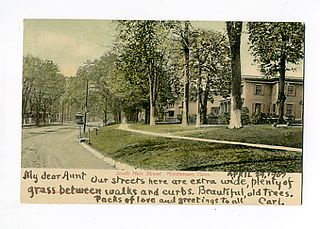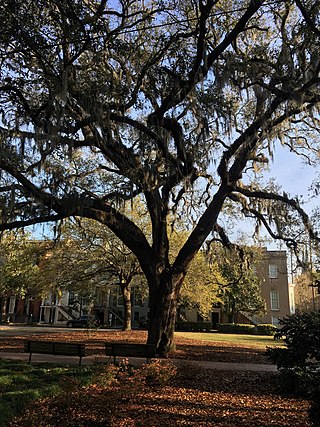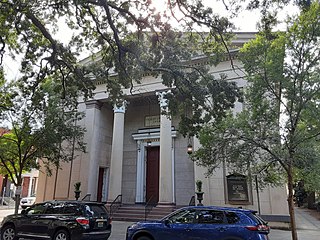
Savannah is the oldest city in the U.S. state of Georgia and the county seat of Chatham County. Established in 1733 on the Savannah River, the city of Savannah became the British colonial capital of the Province of Georgia and later the first state capital of Georgia. A strategic port city in the American Revolution and during the American Civil War, Savannah is today an industrial center and an important Atlantic seaport. It is Georgia's fifth most populous city, with a 2020 U.S. Census population of 147,780. The Savannah metropolitan area, Georgia's third-largest, had a 2020 population of 404,798.

The Sweet Auburn Historic District is a historic African-American neighborhood along and surrounding Auburn Avenue, east of downtown Atlanta, Georgia, United States. The name Sweet Auburn was coined by John Wesley Dobbs, referring to the "richest Negro street in the world," one of the largest concentrations of African-American businesses in the United States.

The Georgia Trust for Historic Preservation is the United States' largest statewide, nonprofit preservation organization with more than 8,000 members. Founded in 1973 by Mary Gregory Jewett and others, the Trust is committed to preserving and enhancing Georgia's communities and their diverse historic resources for the education and enjoyment of all.

Located in Middletown, Connecticut, the Middletown South Green Historic District was created to preserved the historic character of the city's South Green and the historic buildings that surround it. It is a 90-acre (36 ha) historic district that includes a concentration of predominantly residential high-quality architecture from the late 19th century. It was listed on the National Register of Historic Places in 1975.

The Savannah Historic District is a large urban U.S. historic district that roughly corresponds to the pre-civil war city limits of Savannah, Georgia. The area was declared a National Historic Landmark District in 1966, and is one of the largest urban, community-wide historic preservation districts in the United States. The district was made in recognition of the Oglethorpe Plan, a unique sort of urban planning begun by James Oglethorpe at the city's founding and propagated for the first century of its growth.

The Savannah Victorian Historic District is a historic district in Savannah, Georgia. It is mostly residential in character and features Late Victorian, Queen Anne, and other architectural styles.

Mount Vernon Place United Methodist Church and Asbury House is a historic United Methodist church located at 2-10 Mount Vernon Place, Mount Vernon in Baltimore, Maryland. The church "is one of the most photographed buildings in the city, completed in 1872 near the Washington Monument on the site where Francis Scott Key died in 1843. Its sanctuary seats 900 and its rose window is modeled after the one in the Notre Dame Cathedral in Paris."

Lovely Lane United Methodist Church is a historic United Methodist church at 2200 St. Paul Street in the Charles Village neighborhood of Baltimore, Maryland, United States.

Historic First Bryan Baptist Church is an African-American church that was organized in Savannah, Georgia, by Andrew Bryan in 1788. Considered to be the Mother Church of Black Baptists, the site was purchased in 1793 by Bryan, a former slave who had also purchased his freedom. The first structure was erected there in 1794. By 1800 the congregation was large enough to split: those at Bryan Street took the name of First African Baptist Church, and Second and Third African Baptist churches were also established. The current sanctuary of First Bryan Baptist Church was constructed in 1873.
Asbury United Methodist Church or Asbury Methodist Episcopal Church, or variations on Asbury Methodist Church, may refer to:

Second Baptist Church is a historic church building in the village of Mechanicsburg, Ohio, United States. Constructed in the mid-19th century, it is the oldest church in the village, and it has been named a historic site.

Asbury United Methodist Church, founded in 1836 as Asbury Chapel, is the oldest black United Methodist church in Washington, D.C.

The Asbury Historic District is a 288 acres (117 ha) historic district encompassing the community of Asbury in Franklin Township of Warren County, New Jersey. It is bounded by County Route 632, County Route 643, Maple Avenue, Kitchen Road, and School Street and extends along the Musconetcong River into Bethlehem Township of Hunterdon County. It was listed on the National Register of Historic Places on March 19, 1993 for its significance in architecture, industry, religion, community development, politics/government, and commerce. The district includes 141 contributing buildings, a contributing structure, two contributing sites, and four contributing objects.

Calvary Episcopal Church is an Episcopal church in Americus, Georgia. First organized in 1864, the current building was constructed in 1921.

One of the 22 squares of Savannah, Georgia, United States, laid out in 1851 south of Lafayette Square, west of Whitefield Square, and east of Monterey Square, the location long named Calhoun Square has been unnamed since 2022. The oldest buildings on the square, the Adam Short Property and the Alexander Bennett House, date to 1853. Sometimes called Massie Square, the former Massie Common School House was built in 1855. The Wesley Monumental United Methodist Church, founded in 1868, is located on the western side of the square.

Cherry Grove Baptist Church Schoolhouse built c. 1910, is a rural African American school building in the vicinity of Washington, a city in Wilkes County, Georgia. This building is a rare surviving example of this genre of 20th century architecture, and it has importance to African American heritage. It is listed on the National Register of Historic Places since June 23, 2020.
Mary Lane Morrison was an American writer, historian and preservationist. She was the curator of the Georgia Historical Society, a member of the National Society of the Colonial Dames of America in the state of Georgia and was a director in The Victorian Society, founded in 1966. She also wrote John S. Norris: Architect in Savannah, on the architectural work of John S. Norris, and edited Historic Savannah: A Survey of Significant Buildings in the Historic and Victorian Districts of Savannah, Georgia.

Montgomery Street is a prominent street in Savannah, Georgia, United States. Located between Martin Luther King Jr. Boulevard to the west and Jefferson Street to the east, it runs for about 4.21 miles (6.78 km) from Williamson Street in the north to Duncan Drive in the south. The street is named for General Richard Montgomery, who served for the Confederate Army in the American Revolutionary War. Its directional flow is one-way south of West Liberty Street. In March 2019, the formerly one-way section between West Broughton Street and West Liberty Street was converted to two-way, largely to permit visitors to turn right onto West Oglethorpe Avenue in order to drop people off at the entrance to the new Cultural Arts Center.

Trinity Methodist Church, located in Savannah, Georgia, was built in 1848. It stands in the southwestern trust/civic block of Telfair Square.


















